Dynamic Evolution, Regional Differences, and Spatial Spillover Effects of Urban Ecological Welfare Performance in China from the Perspective of Ecological Value
Abstract
1. Introduction
2. Measurement System, Research Methods, and Data Sources
2.1. Constructing the Measurement System
2.1.1. Input Indicators
2.1.2. Output Indicators
2.1.3. Driving Factors
2.2. Research Methods
2.2.1. Super-SBM-DEA Model including Non-Desired Outputs
2.2.2. Dagum Gini Coefficient Decomposition Model
2.2.3. Kernel Density Estimation
2.2.4. Convergence Analysis
2.2.5. Spatial Durbin Model
2.3. Data Sources
3. Empirical Analysis
3.1. Spatial and Temporal Characteristics of EWP
3.2. Regional Differences and Sources of Urban EWP
3.3. Absolute Differences Distribution of Urban EWP
3.4. Spatio-Temporal Convergence Analysis
3.4.1. σ Convergence Analysis
3.4.2. β Convergence Analysis
3.5. Influential Mechanisms
4. Discussion
4.1. About the Evolutionary Features of Urban EWP in National Dimension
4.2. About the Regional Difference Features of Urban EWP in Different Regions
4.3. About the Influential Mechanisms and Spatial Spillover Effects of Urban EWP
4.4. Shortcomings and Future Prospects
5. Conclusions and Policy Implications
5.1. Conclusions
- (1)
- In national, eastern, and western regions, the urban EWP shows a trend of first decreasing and then increasing. The central region has a characteristic of first fluctuating and then improving. The spatial distribution pattern is “high urban EWP in the eastern and western regions, low in the central region”.
- (2)
- For relative difference, the intra-regional differences of urban EWP show the increasing trend in the whole and eastern regions. The central region has a trend of first decreasing and then increasing in fluctuation, while the western region shows a fluctuating characteristic. The inter-regional differences about “East-West” and “Central-West” remain stable, while the difference between “East-Central” shows a slow growth trend. For sources of regional differences, the contribution of supervariable density is the highest, followed by intra-regional difference, and the inter-regional difference is the smallest. For absolute difference, the urban EWP has a significant polarization effect.
- (3)
- There is no σ convergence of urban EWP. However, urban EWP has spatial absolute β convergence and spatial conditional β convergence. Compared with the traditional β convergence analysis, the convergence speed is improved when the spatial correlation is considered.
- (4)
- Urban EWP has a significant spatial correlation. Industrial structure, foreign investment, urbanization, and government intervention all have significant negative effects on EWP. Science and technology progress, finance development, and environmental regulation all show significant positive effects. In space, the spatial spillover effects of industrial structure, urbanization, government intervention, finance development, and environmental regulation are positive, and they are significant except for government intervention. The spatial spillover effects of science and technology progress, and foreign investment are negative, but they are insignificant.
5.2. Policy Countermeasures and Recommendations
- (1)
- At present, many cities have still not yet reached a mature level of EWP, and room remains for its improvement and optimization. Therefore, we should optimize the improvement paths of urban EWP by promoting economic growth, enhancing social welfare, and reducing the ecological deficit. For this, there are two main aspects. On the one hand, we should enhance social security and public services, improve residents’ living environment, and increase residents’ sense of happiness. The specific measures could include improving the efficiency of transforming economic achievements into social welfare, increasing investment in pollution control and ecological restoration, and increasing public participation in social governance. On the other hand, we should reduce the ecological footprint by improving energy utilization structure, enhancing resource utilization, promoting scientific and technological innovation, and increasing factor productivity.
- (2)
- Based on the spatial correlation and heterogeneity characteristics of urban EWP, we should choose differentiated upgrading strategies to promote integrated and coordinated development. In eastern and western regions, urban EWP is higher than in the central region; at the same time, they are all geographically adjacent to the central region. Therefore, core cities should fully release the radiation effect of technology transfer, industrial upgrading, and environmental governance, and drive the green technology renewal, industrial transformation, and upgrading in the central region to reduce pollution emissions and improve environmental quality. In the central region, we should take into account our actual development status and formulate strategies and guidelines that are most suitable for the current stage of development, as well as strive to catch up with the EWP of other regions. Specifically, on the one hand, this could be achieved by integrating internal resources to form scale and agglomeration advantages. On the other hand, plans for technology introduction and industrial upgrading are made according to local conditions. At the same time, in the process of optimizing the economic development model, attention should be paid to the ecological vulnerability of the region and trying to reduce the production of pollutants at the source.
- (3)
- Based on the analysis of the influencing factors of urban EWP, due to the differences in resource endowment, economic and social development conditions, and ecological carrying capacity of different regions, the enhancement mechanisms of their urban EWP are different. Therefore, the precise identification of regional development shortcomings in EWP is important for the effective promotion of coordinated development among regions. In the field of technology, talents, information, and capital, we should focus on inter-regional communication and cooperation, promote the rapid flow of production factors, and push back technological innovation. The specific measures include breaking local protection and trade barriers and accelerating the speed of technology turnover. For foreign investment, we should reduce short-term and medium-term investments and low-end industries. We should also focus on independent innovation as well as avoid the financial risks generated by the excessive inflow of foreign capital.
Supplementary Materials
Author Contributions
Funding
Institutional Review Board Statement
Informed Consent Statement
Data Availability Statement
Conflicts of Interest
References
- Hediger, W. Sustainable development and social welfare. Ecol. Econ. 2000, 32, 481–492. [Google Scholar] [CrossRef]
- Guo, B.N.; Tang, L.; Jiang, Y.Y.; Zhang, H. Regional differences, distribution dynamics and stochastic convergence of ecological welfare performance in China. Ecol. Econ. 2022, 38, 153–160, 176. [Google Scholar]
- Liu, K.; Qiao, Y.; Shi, T.; Zhou, Q. Study on coupling coordination and spatiotemporal heterogeneity between economic development and ecological environment of cities along the Yellow River Basin. Environ. Sci. Pollut. Res 2021, 28, 6898–6912. [Google Scholar] [CrossRef] [PubMed]
- Zhang, C.; Li, J.; Liu, T.; Xu, M.; Wang, H.; Li, X. The Spatiotemporal Evolution and Influencing Factors of the Chinese Cities’ Ecological Welfare Performance. IJERPH 2022, 19, 12955. [Google Scholar] [CrossRef]
- Solow, R.M. The economics of resources or the resources of economics. In Classic Papers in Natural Resource Economics; Palgrave, M., Gopalakrishnan, C., Eds.; Palgrave Macmillan London: London, UK, 1974; pp. 257–275. [Google Scholar] [CrossRef]
- Perroux, F. Economic Space: Theory and Applications. Q. J. Econ. 1950, 64, 89. [Google Scholar] [CrossRef]
- Daly, H.E. Sustainable Development: From Concept and Theory to Operational Principles. Popul. Dev. Rev. 1990, 16, 25. [Google Scholar] [CrossRef]
- Wang, R.; Feng, Y. Research on China’s Ecological Welfare Performance Evaluation and Improvement Path from the Perspective of High-Quality Development. Math. Probl. Eng. 2020, 2020, 1–14. [Google Scholar] [CrossRef]
- Zhou, S.D.; Zhang, Y.Y. Promoting common prosperity in High-Quality Development: A political economy interpretation. Soc. Sci. Xinjiang 2022, 4, 30–40. [Google Scholar] [CrossRef]
- Cao, L.J.; Wang, D.H. Research on the principle and method of establishing sustainable development evaluation index system. Acta Sci. Circum. 1998, 5, 80–86. [Google Scholar]
- Tang, J.B. Three issues of ecological welfare—Based on the perspective of ecological values. J. Nanchang Univ. 2020, 51, 12–20. [Google Scholar] [CrossRef]
- Yang, M.K. National welfare accounting: An exploration about the conceptual foundation. Statis. Res. 2008, 6, 72–77. [Google Scholar] [CrossRef]
- Costanza, R.; Daly, H.E. Natural Capital and Sustainable Development. Conserv. Biol. 1992, 6, 37–46. [Google Scholar] [CrossRef]
- Feng, J.F.; Yuan, J.H. On Chinese regional ecological well-being performance and its influence factors. Forum. Sci. Tech. China 2016, 3, 100–105. [Google Scholar] [CrossRef]
- Common, M. Measuring national economic performance without using prices. Ecol. Econ. 2007, 64, 92–102. [Google Scholar] [CrossRef]
- Xiao, L.M.; Xiao, Q.L. Study on the differentiation and spatial convergence of urban ecological welfare performance patterns in the Yellow River Basin. Soft Sci. 2021, 35, 46–53. [Google Scholar] [CrossRef]
- Zang, M.D.; Zhu, D.j.; Liu, G.P. Ecological well-being performance: Concept, connotation and empirical of G20. China Popul. Res. Environ. 2013, 23, 118–124. [Google Scholar]
- Xiao, L.M.; Zhang, X.P. Spatio-temporal characteristics of coupling coordination between green innovation efficiency and ecological welfare performance under the concept of strong sustainability. J. Nat. Res. 2019, 34, 312–324. [Google Scholar] [CrossRef]
- Yao, L.; Yu, Z.; Wu, M.; Ning, J.; Lv, T. The Spatiotemporal Evolution and Trend Prediction of Ecological Wellbeing Performance in China. Land 2020, 10, 12. [Google Scholar] [CrossRef]
- Du, H.B.; Huang, L.J.; Zhang, C.; He, J.J. Research on the regional differences decomposition and convergence mechanism of ecological well-being performance. Ecol. Econ. 2019, 35, 187–193. [Google Scholar]
- Guo, B.N.; Tang, L.; Jiang, Y.Y.; Zhang, H. Regional differences and spatial convergence of ecological welfare performance in Yangtze River Economic Belt. Ecol. Econ. 2022, 38, 167–175. [Google Scholar]
- Deng, Y.J.; Yang, X.; Ma, Q.W.; Wang, K.D. Regional disparity and convergence of China’s ecological welfare performance level. China Popul. Res. Environ. 2021, 31, 132–143. [Google Scholar]
- Zhu, D.J.; Zhang, S. Research on ecological wellbeing performance and its relationship with economic growth. China Popul. Res. Environ. 2014, 24, 59–67. [Google Scholar]
- Guo, B.N.; Yao, X.F.; Zhang, H. Fiscal vertical imbalance, environmental regulation and ecological welfare performance-An empirical test based on 30 Chinese provincial panel data. Forestry. Econ. 2022, 44, 20–34. [Google Scholar] [CrossRef]
- Long, L.J.; Wang, X.; Guo, B. Evaluation on sustainable urban development from the perspective of ecological wellbeing performance-A case study of Shanghai. Res. Environ. Yangtze Basin 2016, 25, 9–15. [Google Scholar]
- Bian, J.; Ren, H.; Liu, P. Evaluation of urban ecological well-being performance in China: A case study of 30 provincial capital cities. J. Clean. Prod. 2020, 254, 120109. [Google Scholar] [CrossRef]
- Lin, M.X.; Geng, X.; Li, G.Z. Study on the spatial non-equilibrium of provincial ecological welfare performance Level--based on MLD index and distribution dynamics model. Dongyue Trib. 2019, 40, 73–83. [Google Scholar] [CrossRef]
- Wu, D.; Dong, W. Does Local Government’s Competitive Behavior to Attract Foreign Investment Affect Ecological Welfare Performance? Evidence from China. Sustainability 2022, 14, 12903. [Google Scholar] [CrossRef]
- Sun, R. Research on the two-way interaction mechanism between regional economic growth and regional ecological welfare performance. J. Indus. Tech. Econ. 2022, 41, 143–151. [Google Scholar]
- Tianhong, L.; Wenkai, L.; Zhenghan, Q. Variations in ecosystem service value in response to land use changes in Shenzhen. Ecol. Econ. 2010, 69, 1427–1435. [Google Scholar] [CrossRef]
- Hou, J.; Ruan, X.; Lv, J.; Guo, H. Two-Stage Super-Efficiency Slacks-Based Model to Assess China’s Ecological Wellbeing. Int. J. Environ. Res. Public Health 2020, 19, 7045. [Google Scholar] [CrossRef]
- Xiao, L.M.; Ji, H.R. Spatial structure change and influencing factors of ecological well-being performance from the perspective of green technological innovation in China: Data analysis based on provincial panel data. Sci. Tech. Manag. Res. 2018, 38, 243–251. [Google Scholar]
- Xu, Y.D.; Qi, P.; Tong, L.F. Spatial-temporal differentiation of Chinese provincial ecological well-being performance. Reg. Econ. Rev 2017, 4, 123–131. [Google Scholar] [CrossRef]
- Chen, L.; Li, W.; Yuan, K.; Zhang, X. Can informal environmental regulation promote industrial structure upgrading? Evidence from China. Appl. Econ. 2022, 54, 2161–2180. [Google Scholar] [CrossRef]
- Song, X.; Tian, Z.; Ding, C.; Liu, C.; Wang, W.; Zhao, R.; Xing, Y. Digital Economy, Environmental Regulation, and Ecological Well-Being Performance: A Provincial Panel Data Analysis from China. Int. J. Environ. Res. Public Health 2022, 19, 11801. [Google Scholar] [CrossRef]
- Chen, L.; Wang, N.; Li, Q.; Zhou, W. Environmental regulation, foreign direct investment and China’s economic development under the new normal: Restrain or promote? Environ. Dev. Sustain. 2022, 24, 1–22. [Google Scholar] [CrossRef]
- Chen, M.; Ye, C.; Lu, D.; Sui, Y.; Guo, S. Cognition and construction of the theoretical connotations of new urbanization with Chinese characteristics. J. Geogr. Sci. 2019, 29, 1681–1698. [Google Scholar] [CrossRef]
- Li, Y.; Xie, Z.; Li, B.; Mohiuddin, M. The Impacts of In Situ Urbanization on Housing, Mobility and Employment of Local Residents in China. Sustainability 2022, 14, 9058. [Google Scholar] [CrossRef]
- Farnworth, E.G.; Tidrick, T.H.; Jordan, C.F.; Smathers, W.M. The Value of Natural Ecosystems: An Economic and Ecological Framework. Envir. Conserv. 1981, 8, 275–282. [Google Scholar] [CrossRef]
- Fraj, E.; Martinez, E. Ecological consumer behaviour: An empirical analysis. Int. J. Cons. Stud. 2007, 31, 26–33. [Google Scholar] [CrossRef]
- Zhao, X.; Wu, L.; Li, A. Research on the efficiency of carbon trading market in China. Renew. Sustain. Energy. Rev. 2017, 79, 1–8. [Google Scholar] [CrossRef]
- Zhou, X.; Tang, X.; Zhang, R. Impact of green finance on economic development and environmental quality: A study based on provincial panel data from China. Environ. Sci. Pollut. Res. 2020, 27, 19915–19932. [Google Scholar] [CrossRef] [PubMed]
- Demetriades, P.; Hook Law, S. Finance, institutions and economic development. Int. J. Fin. Econ. 2006, 11, 245–260. [Google Scholar] [CrossRef]
- Song, M.; Tao, W.; Shen, Z. Improving high-quality development with environmental regulation and industrial structure in China. J. Clean. Prod. 2022, 366, 132997. [Google Scholar] [CrossRef]
- Wang, X.; Xu, X.H. Spatial-temporal evolution and regional disparity of economic High-quality development in the Yangtze River Economic Belt. Econ Geogr. 2020, 40, 5–15. [Google Scholar]
- Chen, Z.X.; Qing, M.; Yang, Y.Q. Measurement of high-quality development level in Sichuan-Chongqing economic circle and its spatio-temporal convergence. Econ. Geo. 2022, 42, 65–73. [Google Scholar] [CrossRef]
- Yu, W.; Zhang, P.; Ji, Z.H. Study on regional difference, distribution dynamics and convergence of eco-efficiency of urban clusters in China. J. Quanti. Tech. Econ. 2021, 38, 23–42. [Google Scholar] [CrossRef]
- Fan, Q.Q.; Chu, C.J.; Gao, J.N. Effect of environmental regulation and industrial structure upgrade on High-quality Economic Development. China Pop. Res. Environ. 2020, 30, 84–94. [Google Scholar]
- Sun, J.W.; Hu, J.Y. Exploration of the Western Development Strategy based on building a new development pattern. Reg. Econ. Rev. 2022, 2, 23–27. [Google Scholar] [CrossRef]
- Li, X.H.; He, J.Y.; Yan, H. Study on regional differentiation, distribution dynamics and influencing factors of marine economic development in three major marine economic circles of China. J. Nat. Res. 2022, 37, 966–984. [Google Scholar] [CrossRef]
- Chen, S.; Zhang, Y.; Zhang, Y.; Liu, Z. The relationship between industrial restructuring and China’s regional haze pollution: A spatial spillover perspective. J. Clean. Prod. 2019, 239, 115808. [Google Scholar] [CrossRef]
- Xie, R.; Yuan, Y.; Huang, J. Different Types of Environmental Regulations and Heterogeneous Influence on “Green” Productivity: Evidence from China. Ecol. Econ. 2017, 132, 104–112. [Google Scholar] [CrossRef]
- Wang, L.; Guan, Z.H.; Zhang, S.Q.; Li, M.J. Coupling Coordination and Spatial-temporal Differentiation of Chinese Inclusive Finance-Evidence from Chinese Provincial Panel Data. Soft Sci. 2018, 32, 10–15. [Google Scholar] [CrossRef]
- De Santis, R.; Esposito, P.; Lasinio, C.J. Environmental regulation and productivity growth: Main policy challenges. Inter. Econ. 2021, 165, 264–277. [Google Scholar] [CrossRef]
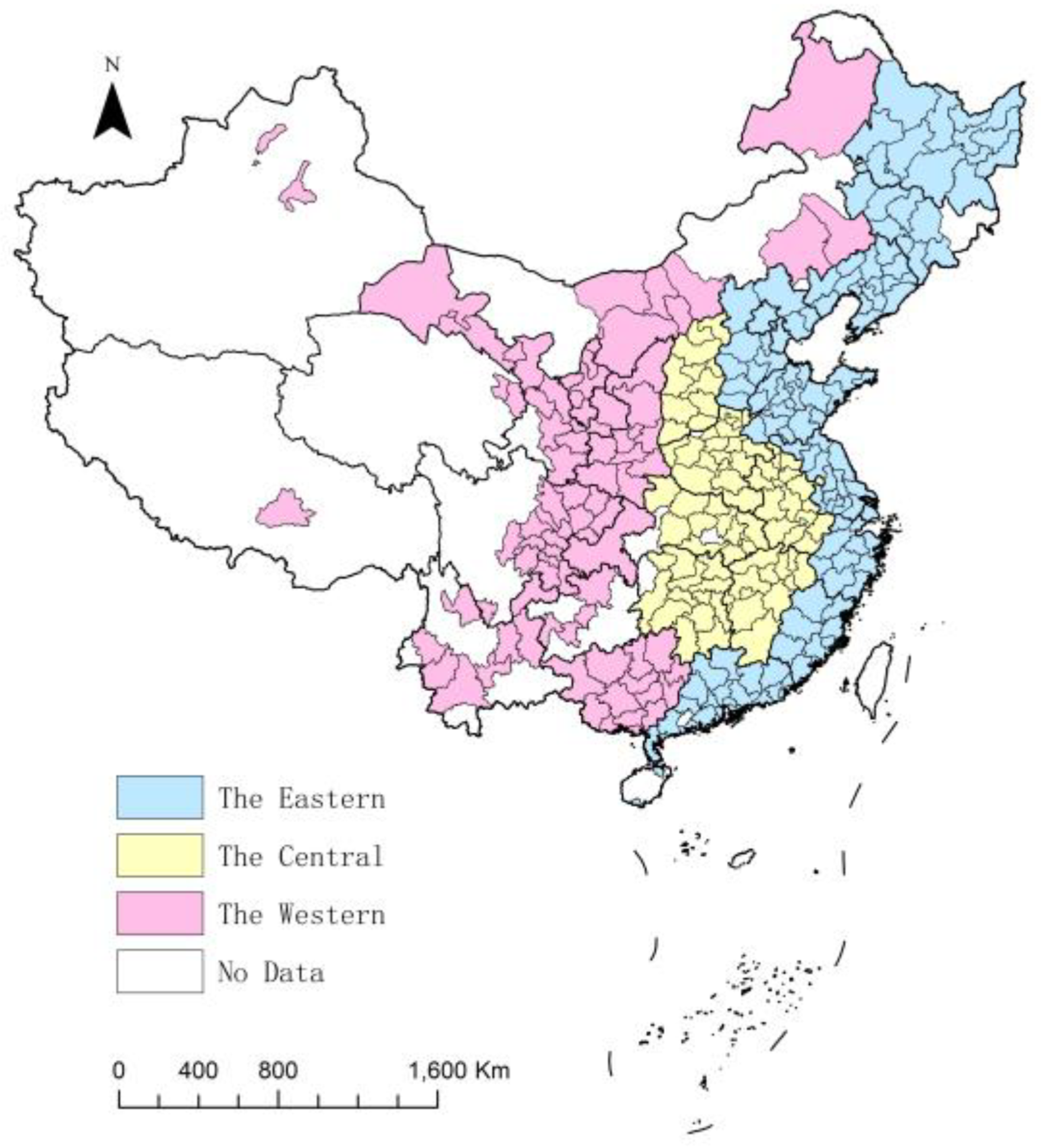
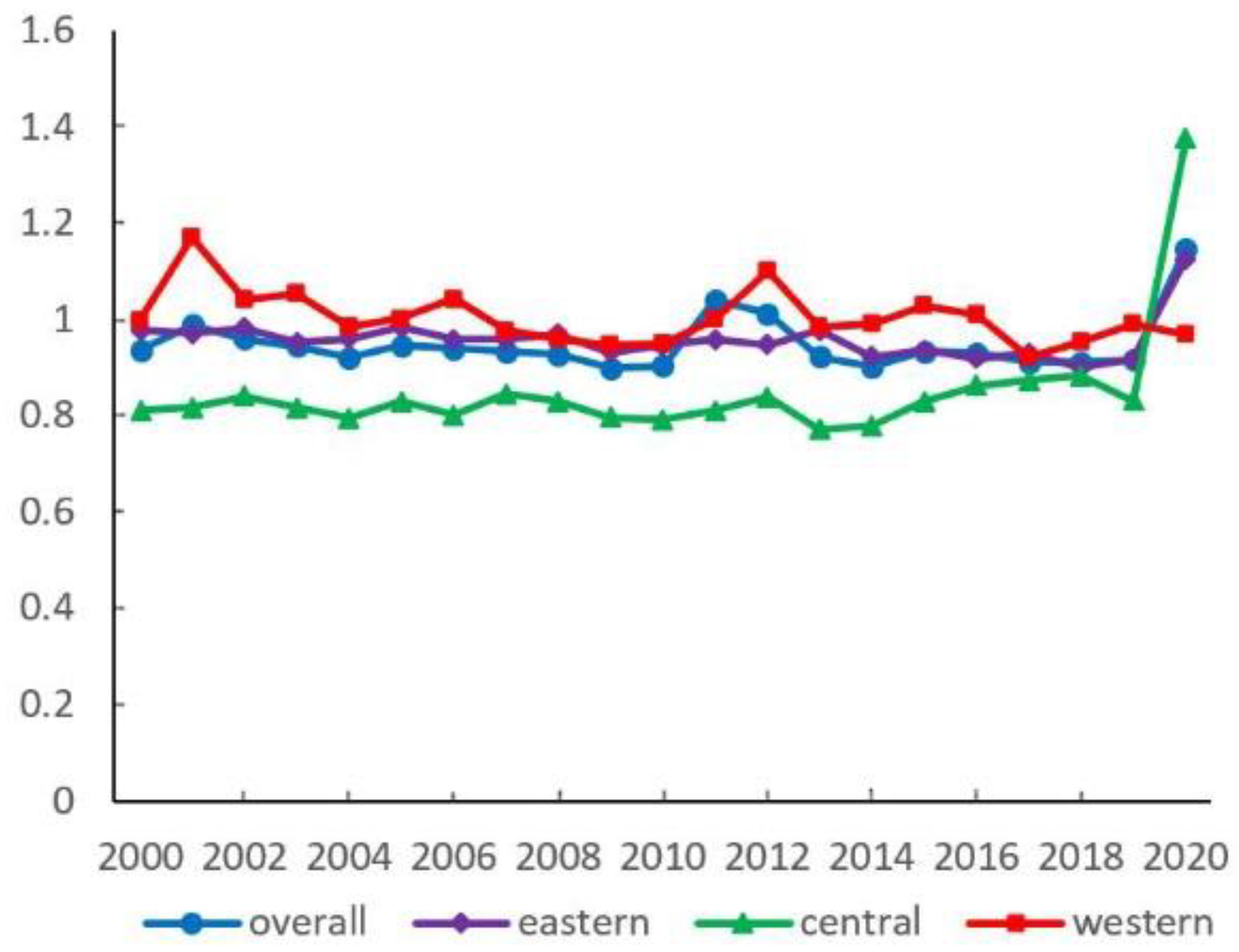
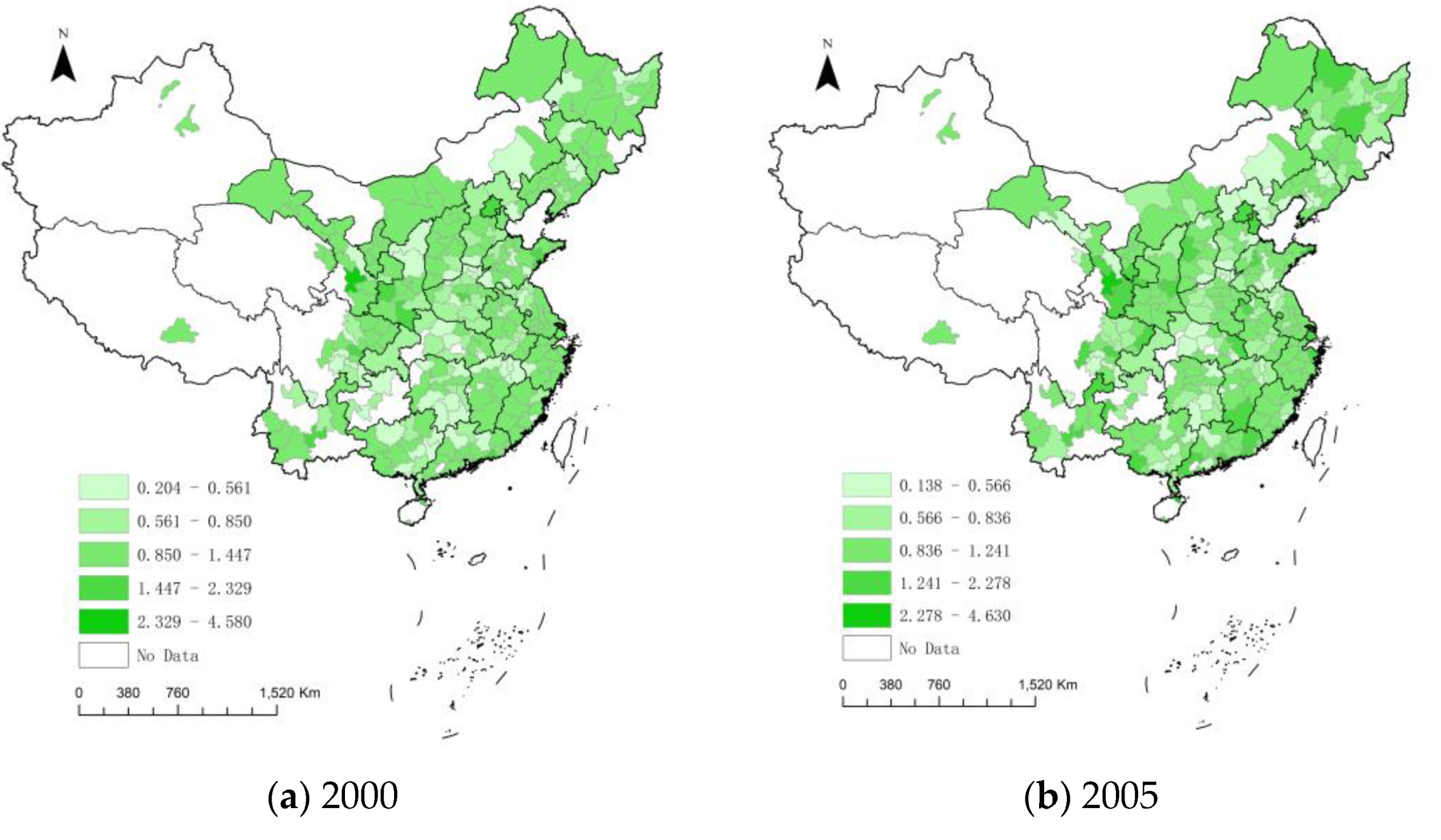
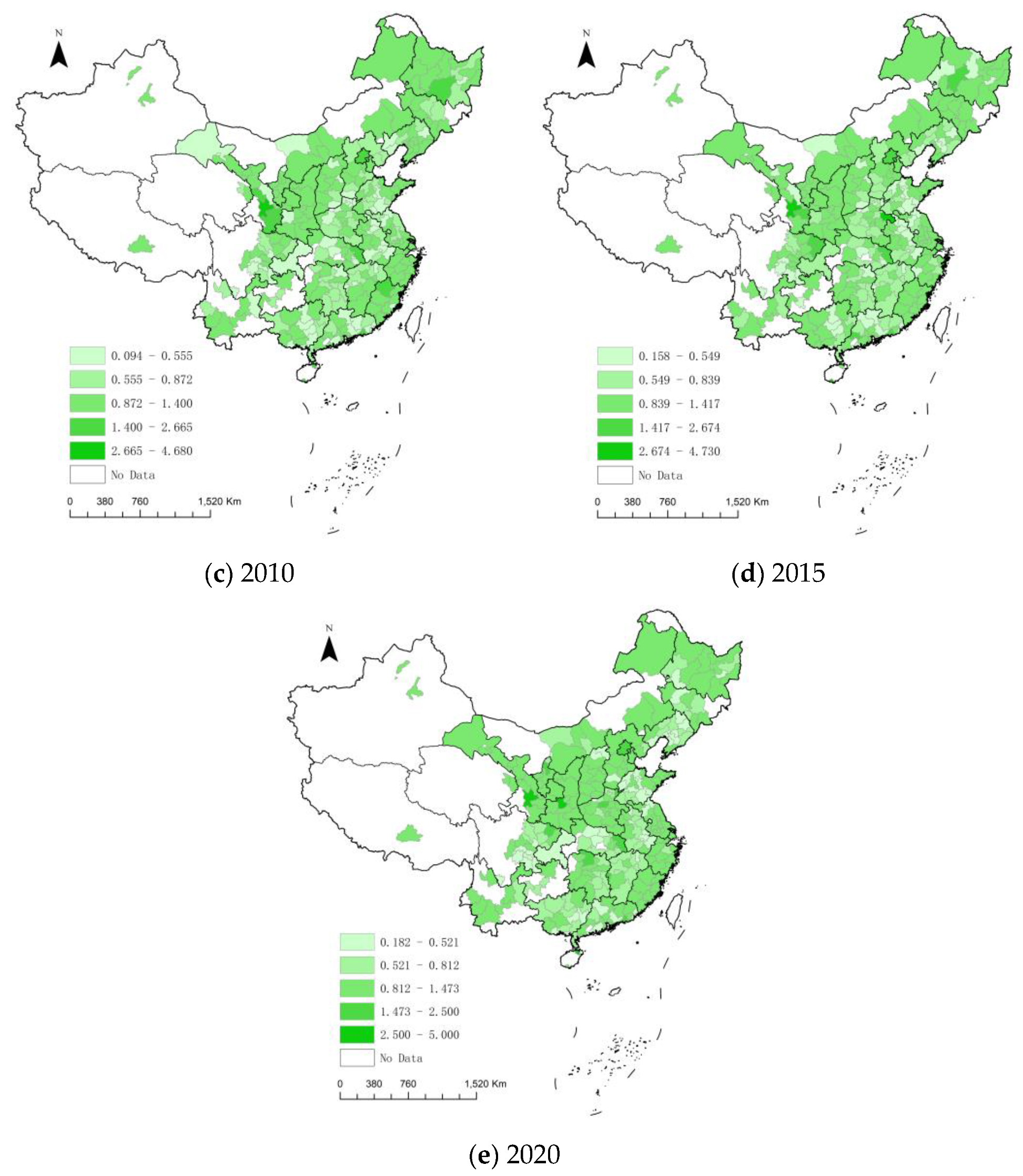
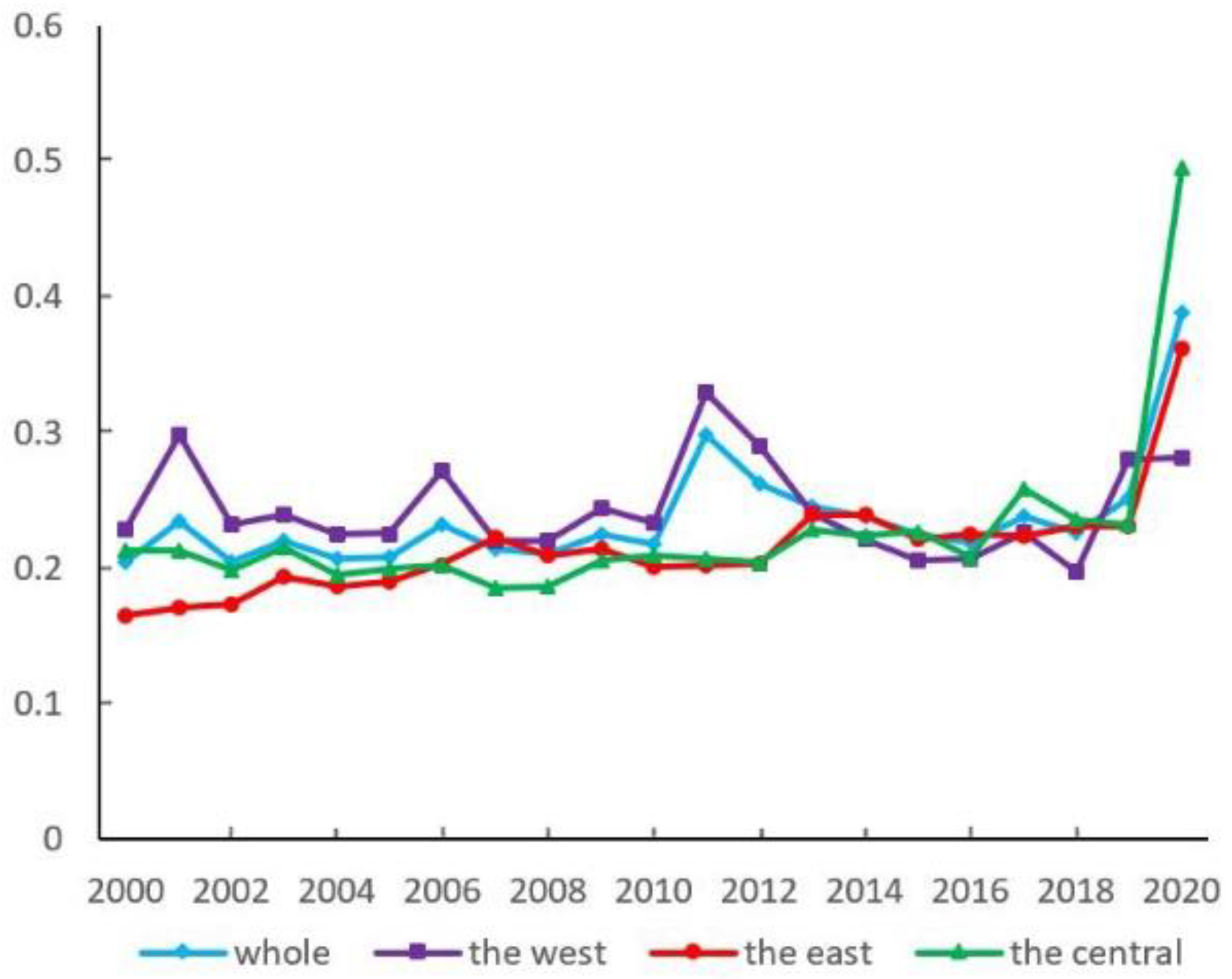

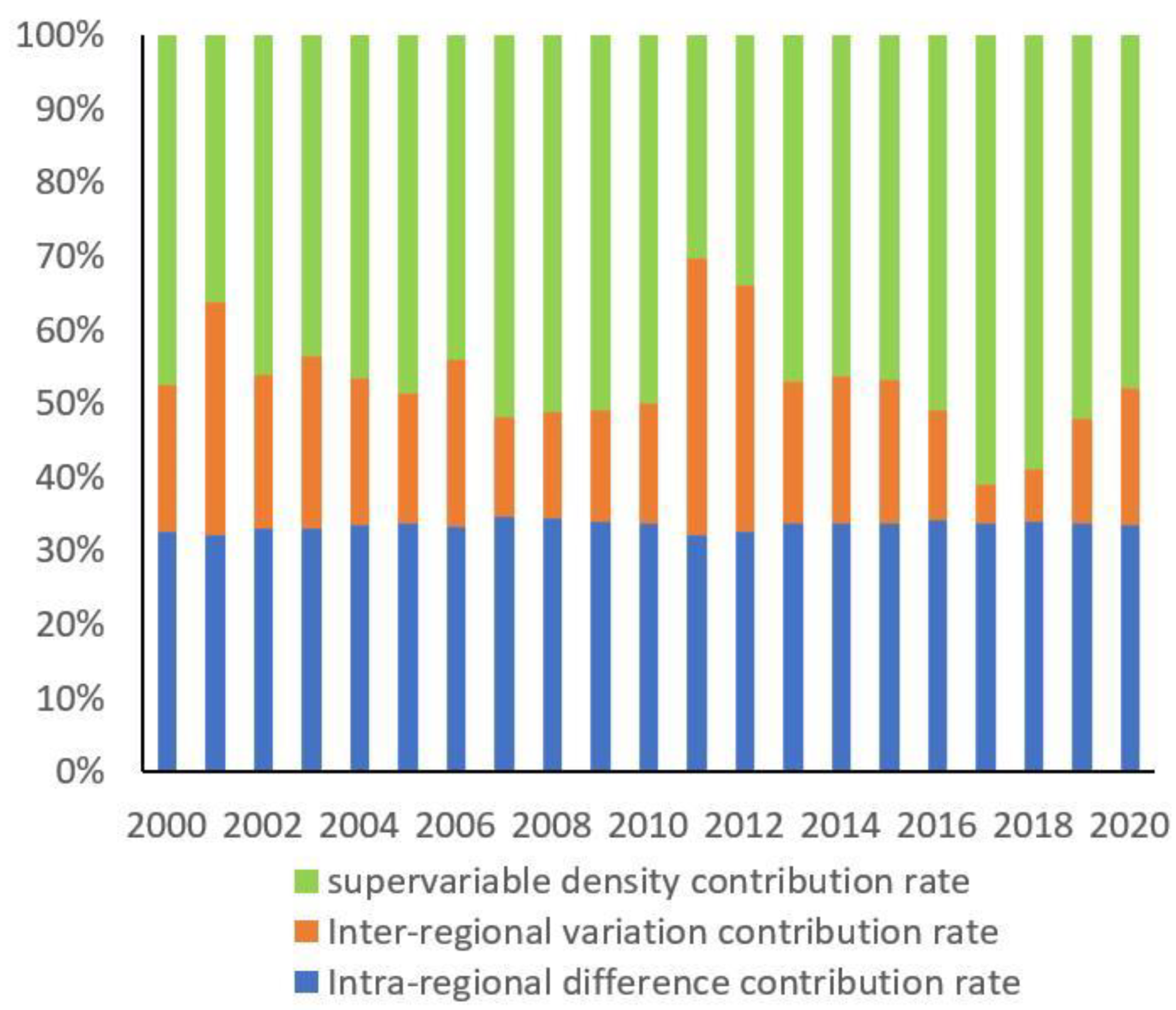

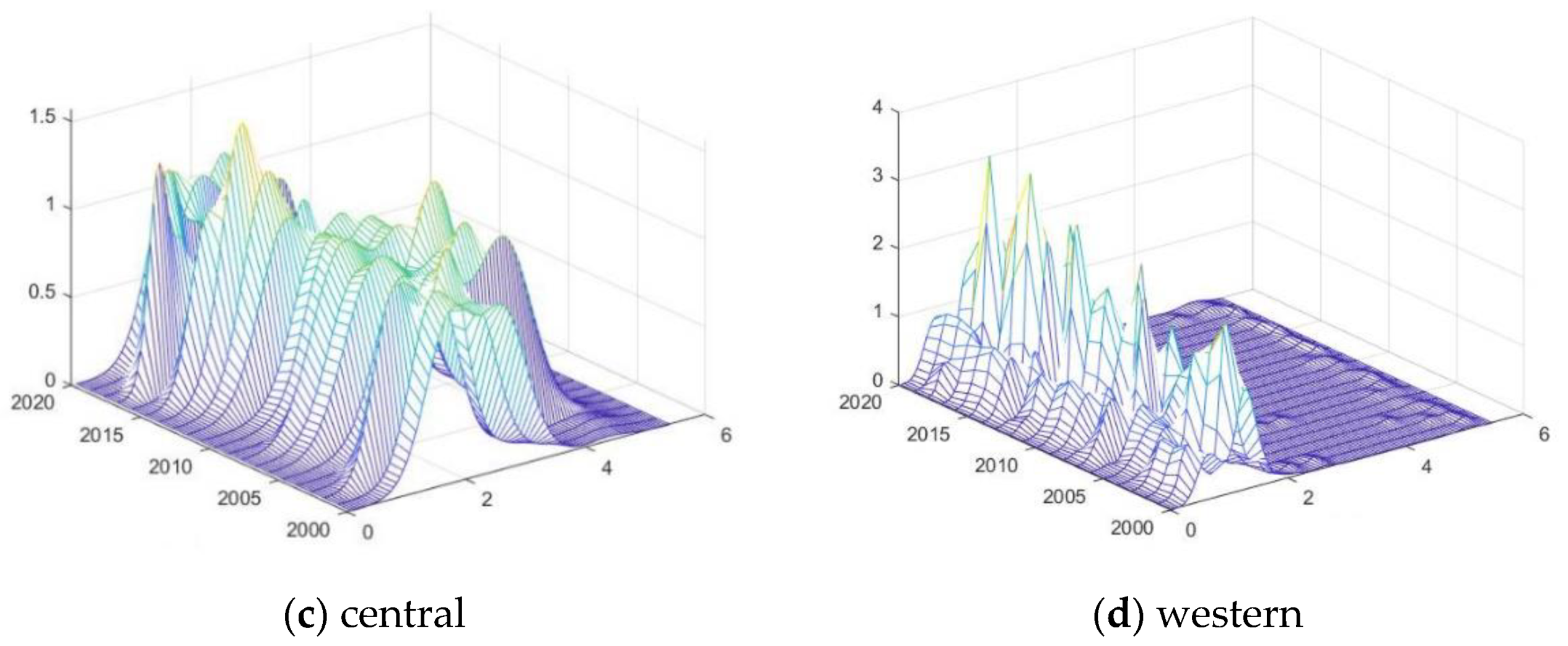
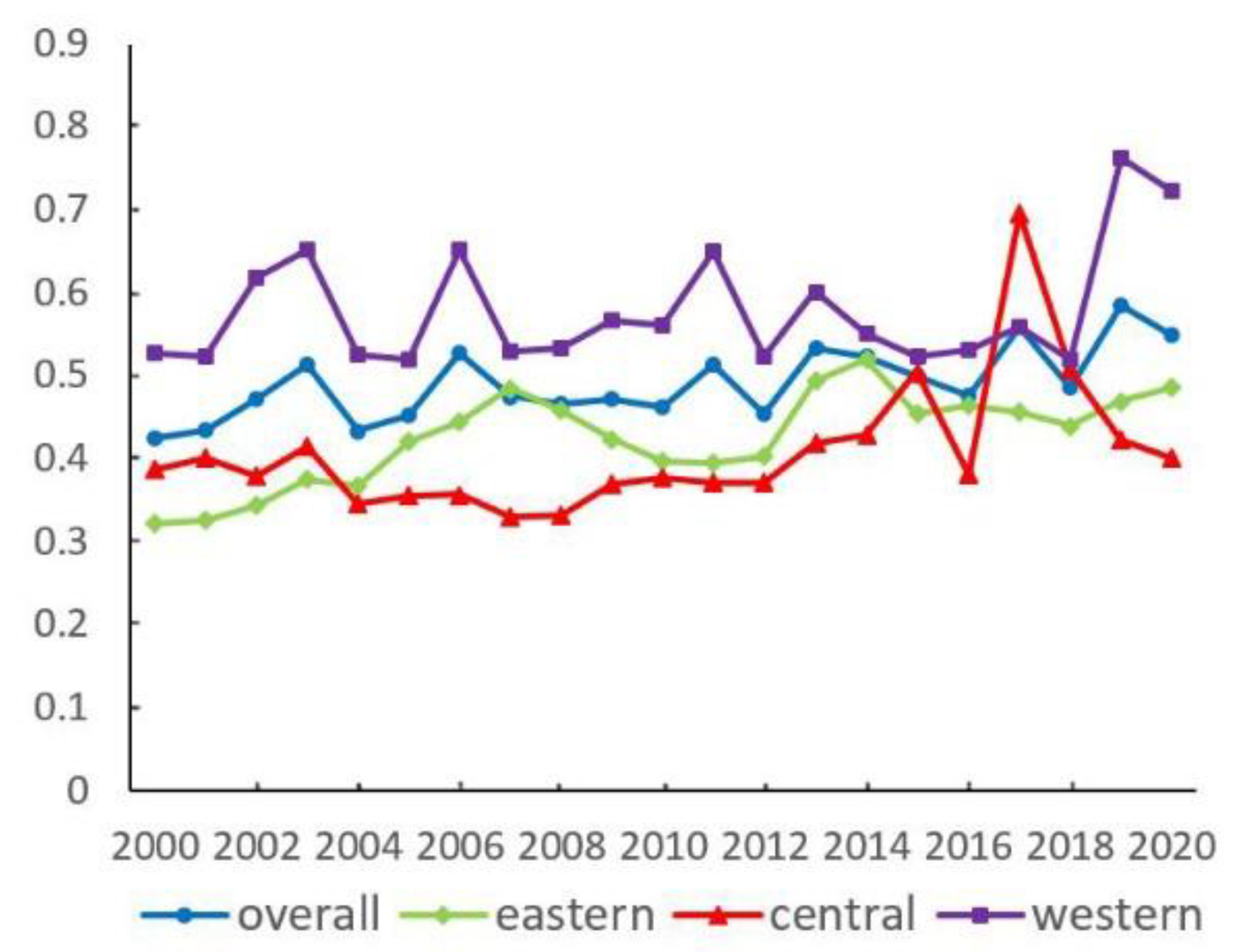
| Category | One-Level Index | Two-Level Index | Three-Level Index |
|---|---|---|---|
| input indicator | resource consumption | energy consumption | per capita consumption of coal gas, natural gas, and liquefied petroleum gas |
| water consumption | water resource per capita | ||
| land resource consumption | urban construction land area per capita | ||
| ecological capital | ecological service supply | green space per capita | |
| greening coverage of built-up areas | |||
| ecological environment improvement | length of drainage pipes per capita | ||
| fixed asset investment in urban municipal utilities construction per capita | |||
| output indicator | undesirable outputs | wastewater emission | industrial wastewater emission per capita |
| exhaust emission | SO2 emission per capita | ||
| solid waste emission | proportion of industrial solid waste not comprehensively used | ||
| desirable outputs | resident health | number of doctors per 10,000 people | |
| number of hospital beds per 10,000 people | |||
| culture and education | number of teachers at college and above per 10,000 people | ||
| number of students in college and above per 10,000 people | |||
| library collections owned per 10,000 people | |||
| economic capability | GDP per capita | ||
| deposits per capita | |||
| fiscal budget expenditure per capita |
| Year | I | z-Value | p-Value | Year | I | z-Value | p-Value | Year | I | z-Value | p-Value |
|---|---|---|---|---|---|---|---|---|---|---|---|
| 2000 | 0.096 | 2.528 | 0.006 | 2007 | 0.305 | 7.851 | 0.000 | 2014 | 0.147 | 3.808 | 0.000 |
| 2001 | 0.106 | 2.768 | 0.003 | 2008 | 0.293 | 7.569 | 0.000 | 2015 | 0.093 | 2.431 | 0.008 |
| 2002 | 0.101 | 2.695 | 0.004 | 2009 | 0.206 | 5.313 | 0.000 | 2016 | 0.135 | 3.493 | 0.000 |
| 2003 | 0.079 | 2.154 | 0.016 | 2010 | 0.198 | 5.105 | 0.000 | 2017 | 0.075 | 2.022 | 0.022 |
| 2004 | 0.14 | 3.664 | 0.000 | 2011 | 0.093 | 2.454 | 0.007 | 2018 | 0.098 | 2.567 | 0.005 |
| 2005 | 0.148 | 3.859 | 0.000 | 2012 | 0.159 | 4.111 | 0.000 | 2019 | 0.083 | 2.212 | 0.013 |
| 2006 | 0.185 | 4.781 | 0.000 | 2013 | 0.091 | 2.375 | 0.009 | 2020 | 0.14 | 3.657 | 0.000 |
| Variable | Whole | East | Central | West | ||||
|---|---|---|---|---|---|---|---|---|
| Non-Space | Space | Non-Space | Space | Non-Space | Space | Non-Space | Space | |
| β | −0.508 *** (−42.73) | −0.512 *** (−44.01) | −0.418 *** (−24.32) | −0.427 *** (−25.24) | −0.498 *** (−22.05) | −0.500 *** (−22.69) | −0.621 *** (−27.12) | −0.621 *** (−27.85) |
| ρ | - | 0.097 *** (5.22) | - | 0.129 *** (5.06) | - | 0.059 *** (4.61) | - | 0.046 *** (4.42) |
| s | 0.034 | 0.034 | 0.026 | 0.027 | 0.033 | 0.033 | 0.046 | 0.046 |
| t | 20.522 | 20.289 | 26.892 | 26.139 | 21.122 | 21.000 | 15.003 | 15.003 |
| N | 287 | 287 | 121 | 121 | 80 | 80 | 86 | 86 |
| R2 | 0.086 | 0.087 | 0.065 | 0.066 | 0.098 | 0.098 | 0.108 | 0.109 |
| Log-L | - | 123.667 | - | 255.588 | - | 144.120 | - | 160.439 |
| Variable | Whole | East | Central | West | ||||
|---|---|---|---|---|---|---|---|---|
| Non-Space | Space | Non-Space | Space | Non-Space | Space | Non-Space | Space | |
| β | −0.516 *** (−43.14) | −0.519 *** (−44.46) | −0.439 *** (−25.15) | −0.447 *** (−26.03) | −0.525 *** (−22.80) | −0.544 *** (−23.98) | −0.630 *** (−27.40) | −0.633 *** (−28.32) |
| ρ | - | 0.092 *** (4.89) | - | 0.119 *** (4.63) | - | 0.030 *** (3.81) | - | 0.040 *** (3.24) |
| s | 0.035 | 0.035 | 0.028 | 0.028 | 0.035 | 0.037 | 0.047 | 0.048 |
| t | 20.059 | 19.888 | 25.182 | 24.572 | 19.553 | 18.537 | 14.640 | 14.521 |
| con_ | Yes | Yes | Yes | Yes | Yes | Yes | Yes | Yes |
| N | 287 | 287 | 121 | 121 | 80 | 80 | 86 | 86 |
| R2 | 0.084 | 0.086 | 0.050 | 0.051 | 0.1037 | 0.092 | 0.110 | 0.111 |
| Log-L | - | 143.216 | - | 279.108 | - | 171.377 | - | 177.690 |
| Variable | Coefficient | Variable | Spatial Spillover Effect | Variable | Direct Effect | Indirect Effect | Total Effect |
|---|---|---|---|---|---|---|---|
| lnindus | −0.414 *** (−15.68) | wlnindus | 0.328 *** (8.55) | lnindus | −0.400 *** (−15.17) | 0.291 *** (6.87) | −0.109 *** (−2.57) |
| lntech | 0.066 *** (7.58) | wlntech | −0.016 (−1.27) | lntech | 0.065 *** (7.96) | −0.001 (−0.08) | 0.064 *** (4.47) |
| lnfore | −0.010 ** (−2.07) | wlnfore | −0.0002 (−0.03) | lnfore | −0.010 ** (−2.14) | −0.003 (−0.40) | −0.013 * (−1.79) |
| lnurban | −0.094 *** (−9.92) | wlnurban | 0.044 *** (2.76) | lnurban | −0.093 *** (−10.27) | 0.029 (1.56) | −0.064 *** (−3.45) |
| lngovern | −0.053 *** (−3.81) | wlngovern | 0.034 (1.61) | lngovern | −0.051 *** (−3.90) | 0.029 (1.14) | −0.02 (−0.89) |
| lnfinan | 0.183 *** (9.61) | wlnfinan | 0.093 *** (3.11) | lnfinan | 0.191 *** (9.98) | 0.157 *** (4.88) | 0.348 *** (10.23) |
| lnenvir | −0.039 *** (−5.20) | wlnenvir | 0.080 *** (5.26) | lnenvir | −0.035 *** (−4.48) | 0.088 *** (4.66) | 0.053 ** (2.48) |
| rho | 0.210 *** (12.33) | R2 | 0.256 | Log_L | 419.3391 | ||
| Variable | East | Central | West | Variable | East | Central | West |
|---|---|---|---|---|---|---|---|
| lnindus | −0.453 *** (−10.32) | −0.431 *** (−7.85) | −0.325 *** (−7.46) | wlnindus | 0.134 ** (2.02) | 0.519 *** (5.52) | 0.337 *** (5.29) |
| lntech | 0.066 *** (4.65) | −0.032 **(−2.09) | 0.079 *** (5.11) | wlntech | 0.023 (1.25) | −0.066 *** (−2.73) | −0.053 ** (−2.29) |
| lnfore | 0.069 *** (7.34) | 0.002(0.15) | −0.046 *** (−6.10) | wlnfore | 0.027 ** (2.08) | −0.024 (−1.42) | −0.025 ** (−2.12) |
| lnurban | −0.055 *** (−3.55) | −0.134 *** (−9.20) | −0.115 *** (−6.28) | wlnurban | −0.007 (−0.28) | −0.089 *** (−2.57) | 0.006 (0.20) |
| lngovern | −0.150 *** (−6.20) | −0.046 *(−1.71) | 0.028(1.21) | wlngovern | 0.026 (0.71) | 0.147 *** (2.77) | 0.032 (0.86) |
| lnfinan | 0.168 *** (5.18) | 0.349 *** (10.36) | 0.144 *** (4.34) | wlnfinan | −0.008 (−0.18) | −0.252 *** (−4.59) | 0.179 *** (3.90) |
| lnenvir | −0.100 *** (−8.09) | −0.025 **(−2.33) | 0.018 (1.12) | wlnenvir | −0.037 (−1.64) | 0.023 (0.98) | 0.006 (0.20) |
| rho | 0.118 *** (4.61) | 0.078 *** (2.12) | 0.182 *** (6.39) | R2 | 0.369 | 0.3798 | 0.3372 |
| Log_L | 1334.3098 | 658.3544 | 1029.6936 |
Publisher’s Note: MDPI stays neutral with regard to jurisdictional claims in published maps and institutional affiliations. |
© 2022 by the authors. Licensee MDPI, Basel, Switzerland. This article is an open access article distributed under the terms and conditions of the Creative Commons Attribution (CC BY) license (https://creativecommons.org/licenses/by/4.0/).
Share and Cite
Wang, J.; Zhang, G. Dynamic Evolution, Regional Differences, and Spatial Spillover Effects of Urban Ecological Welfare Performance in China from the Perspective of Ecological Value. Int. J. Environ. Res. Public Health 2022, 19, 16271. https://doi.org/10.3390/ijerph192316271
Wang J, Zhang G. Dynamic Evolution, Regional Differences, and Spatial Spillover Effects of Urban Ecological Welfare Performance in China from the Perspective of Ecological Value. International Journal of Environmental Research and Public Health. 2022; 19(23):16271. https://doi.org/10.3390/ijerph192316271
Chicago/Turabian StyleWang, Jun, and Guixiang Zhang. 2022. "Dynamic Evolution, Regional Differences, and Spatial Spillover Effects of Urban Ecological Welfare Performance in China from the Perspective of Ecological Value" International Journal of Environmental Research and Public Health 19, no. 23: 16271. https://doi.org/10.3390/ijerph192316271
APA StyleWang, J., & Zhang, G. (2022). Dynamic Evolution, Regional Differences, and Spatial Spillover Effects of Urban Ecological Welfare Performance in China from the Perspective of Ecological Value. International Journal of Environmental Research and Public Health, 19(23), 16271. https://doi.org/10.3390/ijerph192316271







